Abstract
The effect of dosage and the relative importance of peak and trough concentrations in serum for efficacy of teicoplanin were examined in a rabbit model of aortic valve endocarditis. Concentrations of teicoplanin in serum exceeded the MIC by several hundredfold, yet teicoplanin was less rapidly bactericidal than penicillin both in vitro and for endocarditis caused by a strain of Streptococcus sanguis. Because teicoplanin was 90% protein bound in rabbit serum, low free-drug concentrations probably resulted in less activity in vivo than in vitro. Because teicoplanin has a relatively low bactericidal rate and a high degree of protein binding, a sustained concentration in serum several times greater than the MIC may be important for efficacy in vivo. An intravenous regimen with relatively high peak concentrations in serum was less effective than an intramuscular regimen for endocarditis caused by a strain of Staphylococcus aureus, indicating that high peaks are unlikely to be an important determinant of efficacy. The therapeutically more relevant concentration in serum may be the trough.
Full text
PDF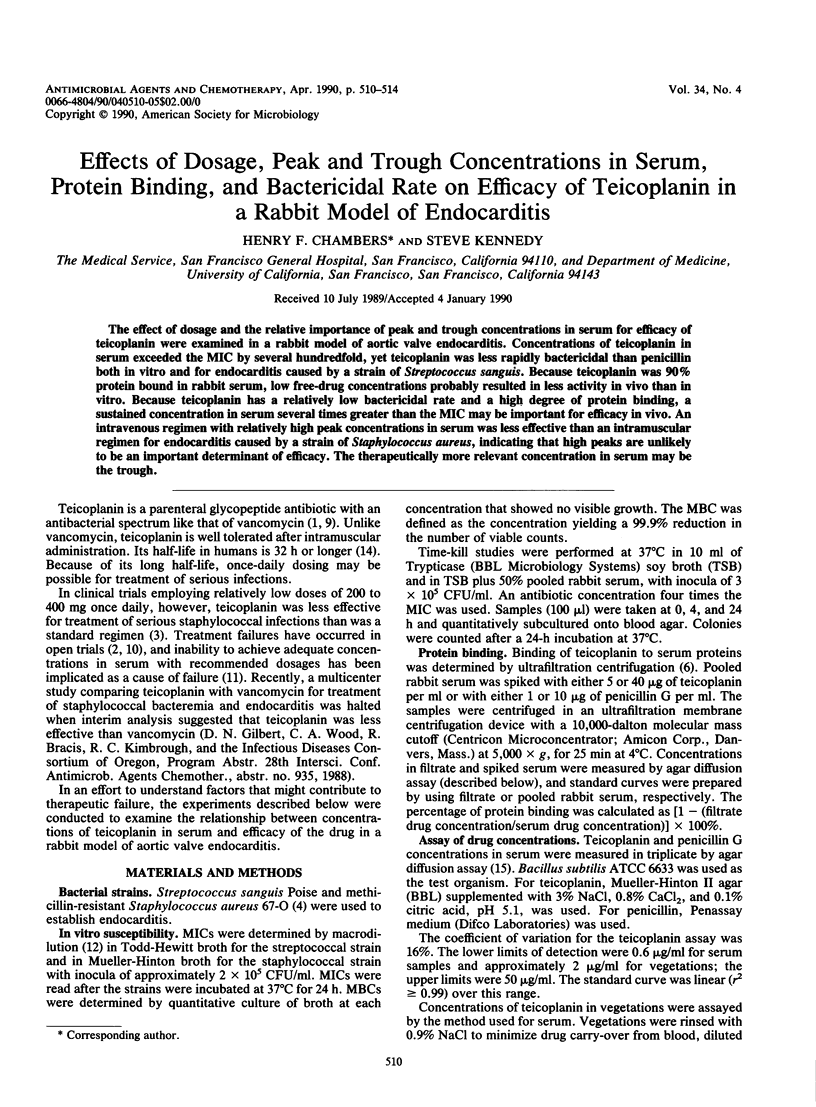
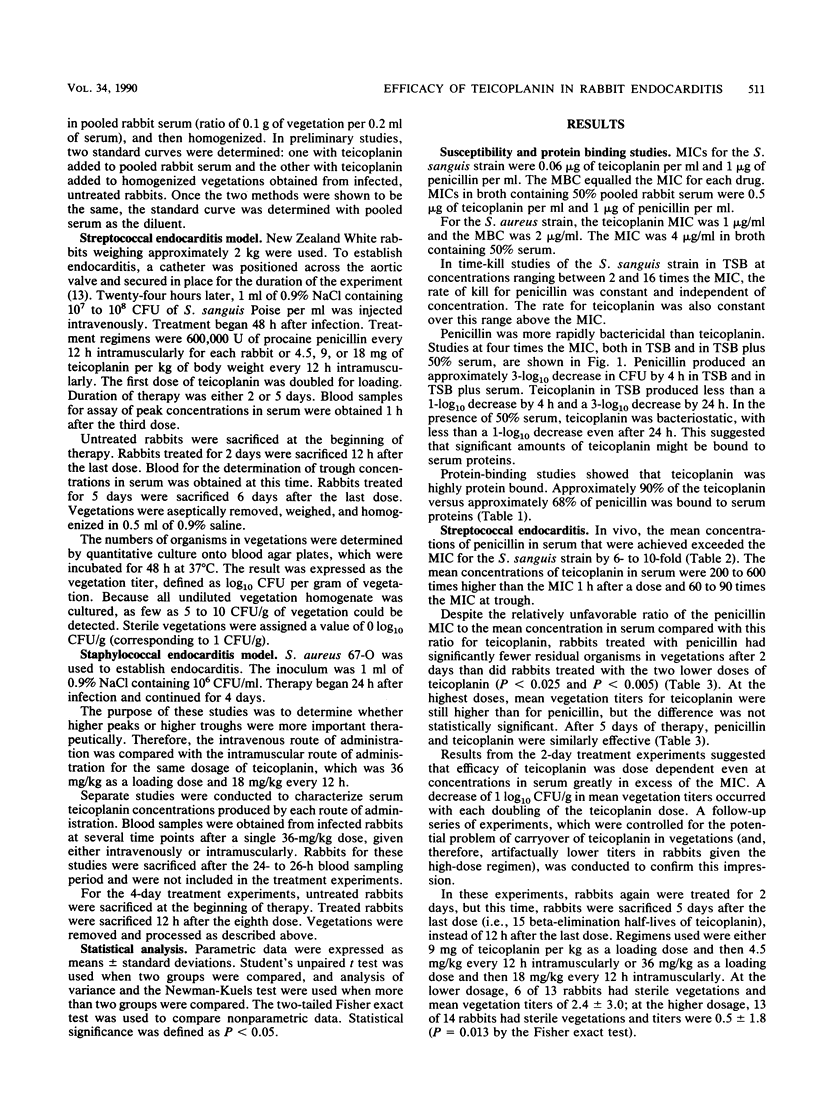
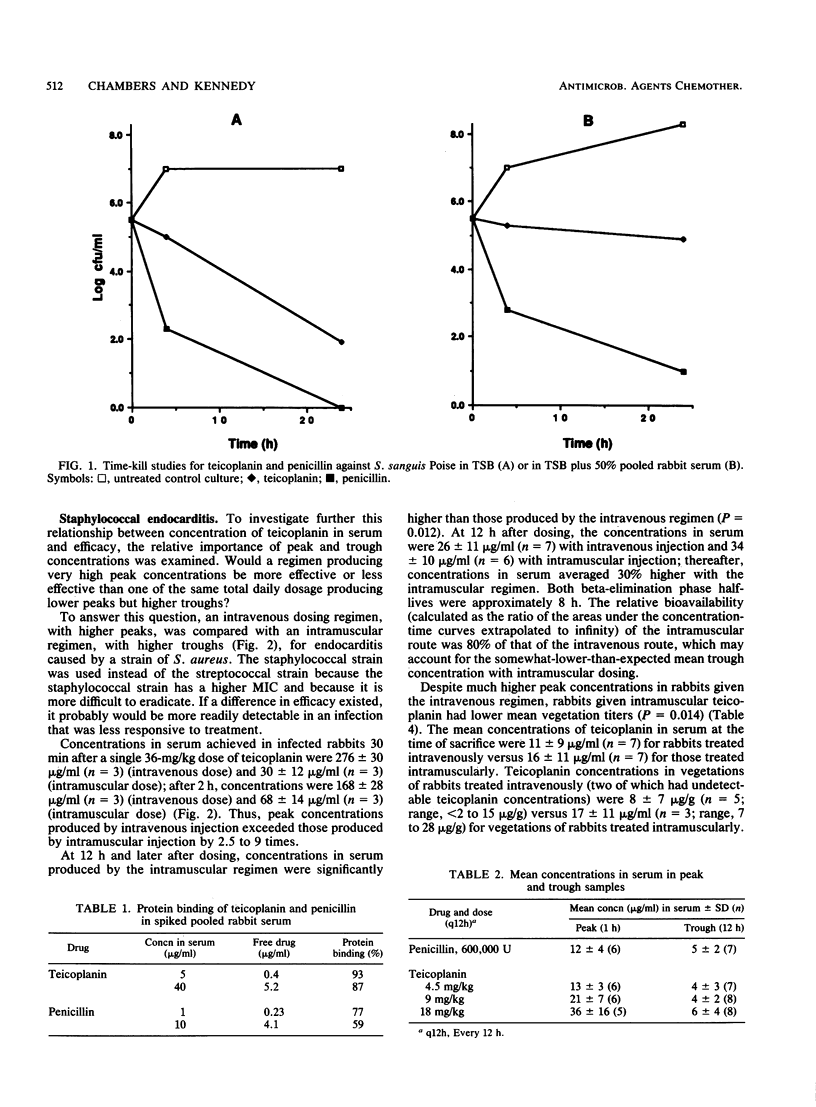
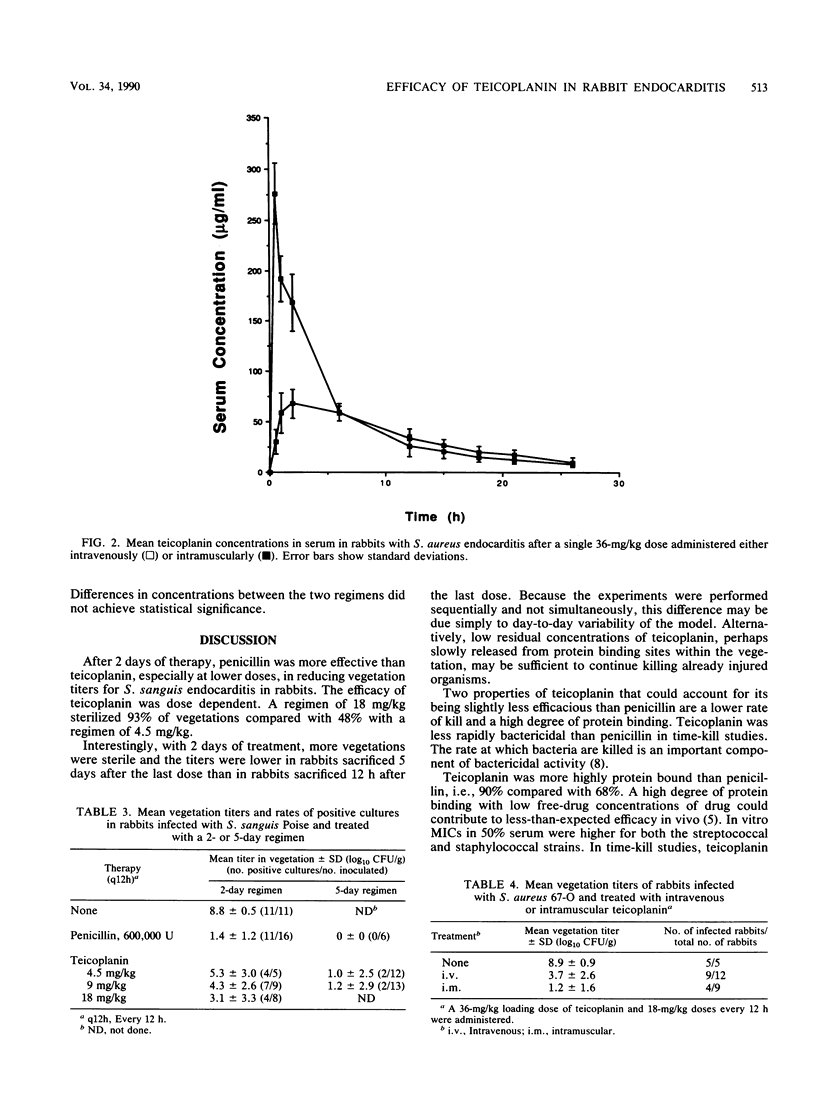
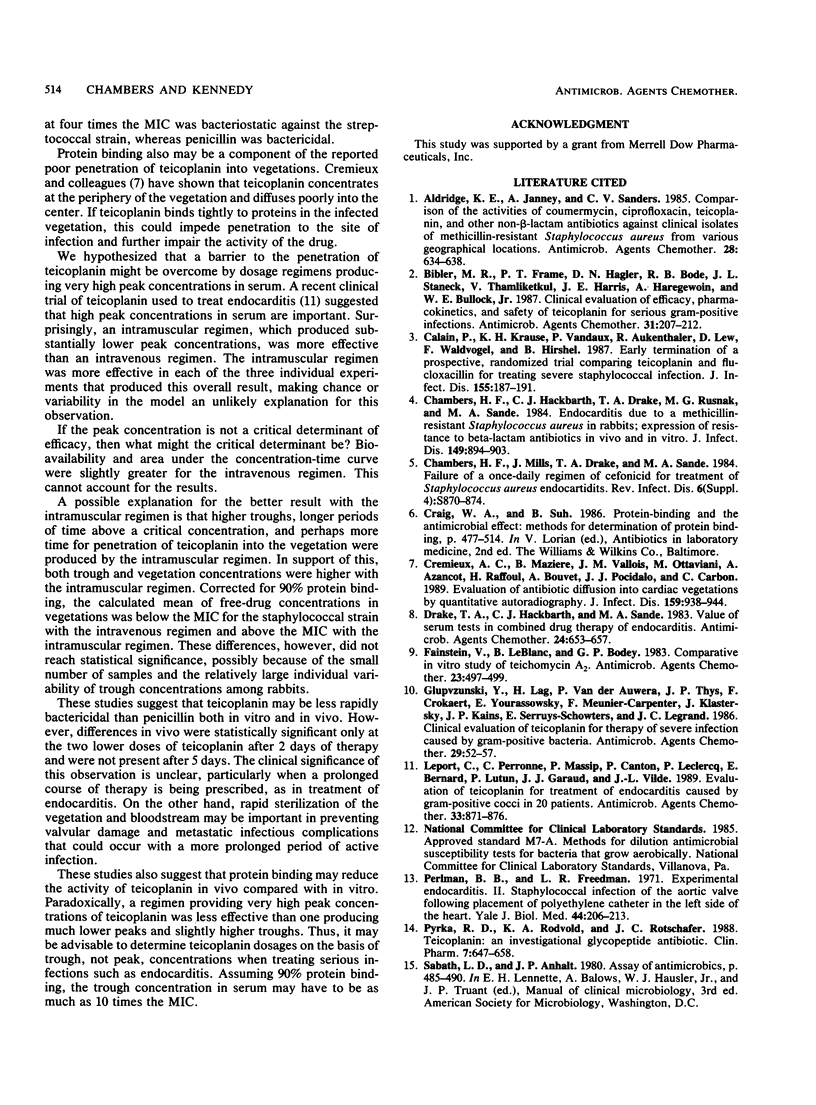
Selected References
These references are in PubMed. This may not be the complete list of references from this article.
- Aldridge K. E., Janney A., Sanders C. V. Comparison of the activities of coumermycin, ciprofloxacin, teicoplanin, and other non-beta-lactam antibiotics against clinical isolates of methicillin-resistant Staphylococcus aureus from various geographical locations. Antimicrob Agents Chemother. 1985 Nov;28(5):634–638. doi: 10.1128/aac.28.5.634. [DOI] [PMC free article] [PubMed] [Google Scholar]
- Bibler M. R., Frame P. T., Hagler D. N., Bode R. B., Staneck J. L., Thamlikitkul V., Harris J. E., Haregewoin A., Bullock W. E., Jr Clinical evaluation of efficacy, pharmacokinetics, and safety of teicoplanin for serious gram-positive infections. Antimicrob Agents Chemother. 1987 Feb;31(2):207–212. doi: 10.1128/aac.31.2.207. [DOI] [PMC free article] [PubMed] [Google Scholar]
- Calain P., Krause K. H., Vaudaux P., Auckenthaler R., Lew D., Waldvogel F., Hirschel B. Early termination of a prospective, randomized trial comparing teicoplanin and flucloxacillin for treating severe staphylococcal infections. J Infect Dis. 1987 Feb;155(2):187–191. doi: 10.1093/infdis/155.2.187. [DOI] [PubMed] [Google Scholar]
- Chambers H. F., Hackbarth C. J., Drake T. A., Rusnak M. G., Sande M. A. Endocarditis due to methicillin-resistant Staphylococcus aureus in rabbits: expression of resistance to beta-lactam antibiotics in vivo and in vitro. J Infect Dis. 1984 Jun;149(6):894–903. doi: 10.1093/infdis/149.6.894. [DOI] [PubMed] [Google Scholar]
- Chambers H. F., Mills J., Drake T. A., Sande M. A. Failure of a once-daily regimen of cefonicid for treatment of endocarditis due to Staphylococcus aureus. Rev Infect Dis. 1984 Nov-Dec;6 (Suppl 4):S870–S874. doi: 10.1093/clinids/6.supplement_4.s870. [DOI] [PubMed] [Google Scholar]
- Cremieux A. C., Maziere B., Vallois J. M., Ottaviani M., Azancot A., Raffoul H., Bouvet A., Pocidalo J. J., Carbon C. Evaluation of antibiotic diffusion into cardiac vegetations by quantitative autoradiography. J Infect Dis. 1989 May;159(5):938–944. doi: 10.1093/infdis/159.5.938. [DOI] [PubMed] [Google Scholar]
- Drake T. A., Hackbarth C. J., Sande M. A. Value of serum tests in combined drug therapy of endocarditis. Antimicrob Agents Chemother. 1983 Nov;24(5):653–657. doi: 10.1128/aac.24.5.653. [DOI] [PMC free article] [PubMed] [Google Scholar]
- Fainstein V., LeBlanc B., Bodey G. P. Comparative in vitro study of teichomycin A2. Antimicrob Agents Chemother. 1983 Mar;23(3):497–499. doi: 10.1128/aac.23.3.497. [DOI] [PMC free article] [PubMed] [Google Scholar]
- Glupczynski Y., Lagast H., Van der Auwera P., Thys J. P., Crokaert F., Yourassowsky E., Meunier-Carpentier F., Klastersky J., Kains J. P., Serruys-Schoutens E. Clinical evaluation of teicoplanin for therapy of severe infections caused by gram-positive bacteria. Antimicrob Agents Chemother. 1986 Jan;29(1):52–57. doi: 10.1128/aac.29.1.52. [DOI] [PMC free article] [PubMed] [Google Scholar]
- Leport C., Perronne C., Massip P., Canton P., Leclercq P., Bernard E., Lutun P., Garaud J. J., Vilde J. L. Evaluation of teicoplanin for treatment of endocarditis caused by gram-positive cocci in 20 patients. Antimicrob Agents Chemother. 1989 Jun;33(6):871–876. doi: 10.1128/aac.33.6.871. [DOI] [PMC free article] [PubMed] [Google Scholar]
- Perlman B. B., Freedman L. R. Experimental endocarditis. II. Staphylococcal infection of the aortic valve following placement of a polyethylene catheter in the left side of the heart. Yale J Biol Med. 1971 Oct;44(2):206–213. [PMC free article] [PubMed] [Google Scholar]
- Pryka R. D., Rodvold K. A., Rotschafer J. C. Teicoplanin: an investigational glycopeptide antibiotic. Clin Pharm. 1988 Sep;7(9):647–658. [PubMed] [Google Scholar]


